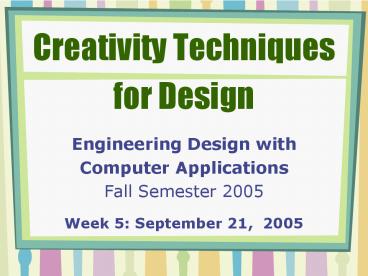Creativity Techniques for Design PowerPoint PPT Presentation
1 / 23
Title: Creativity Techniques for Design
1
Creativity Techniquesfor Design
- Engineering Design with
- Computer Applications
- Fall Semester 2005
- Week 5 September 21, 2005
2
First Things
- DUE Team Assignment 4 on Functional Models
(Submitted via Blackboard) - Team Assignment 5 Creative partial solutions due
Wednesday, 28-September-2005 - Design Report 1 Due Wednesday, 5-October-2005
3
Creativity
- MYTH
- Creative people are highly intelligent
- FACT
- No correlation between creativity and intelligence
4
Todays Topics
- Refer to Ch. 4, p. 48-55 in textbook
- Creativity
- Characteristics
- Techniques
- Intuitive Methods
- Directed Search Methods
- Generating Ideas
- Morphological Matrices
5
Creativity Characteristics (1)
- Creative designers ARE
- Able to visualize, generate and manipulate visual
images in their head - Knowledgeable of existing electromechanical
devices - Able to manipulate partial solutions (i.e., can
break large problem into small parts that are
easier to work with - Willing to take intellectual risks
6
Creativity Characteristics (2)
- Creative designers ARE
- NON-conformists
- Constructive (YOU want to be this)
- Obstructive
- Multiple approaches to problem solving
- Creative designers NEED
- Work environments that allow risk taking
- PRACTICE developing creative skills
7
Creativity Characteristics (3)
Summary
- A creative designer
- is a person of average intelligence
- is a visualizer
- is a hard worker
- is a constructive nonconformist
- has knowledge about the domain
- has ability to dissect things in his/her head
8
Creativity Techniques (1)
- Intuitive Methods rely on knowledge contained
within team - Brainstorming
- Group should represent variety of disciplines
- Must shed intellectual inhibitions
- Record all ideas (use scribe)
- Evaluate feasibility only AFTER idea generation
concludes
9
Creativity Techniques (2)
- Brainstorming is generating as many ideas for
solving a problem as possible in a short period
of time. - Keys to successful brainstorming
- No criticism of ideas!
- Evaluation comes later
- Criticism quenches creative fire it shuts off
the flow of ideas - Welcome creative thinking
- Encourage wild ideas
- They expand the envelope of ideas, possibly
leading to workable solutions we otherwise never
would have reached
10
Creativity Techniques (3)
- Brainstorming is generating as many ideas for
solving a problem as possible in a short period
of time. - Keys to successful brainstorming
- Aim for quantity of ideas
- Allow combining and extending ideas
- Encourage interaction among team members
- Run the rut on an idea
11
Creativity Techniques (4)
- Directed Search Methods Focuses search outside
of team knowledge - Patent search
- Rich source of information
- Time consuming
- Web search (Google, Yahoo )
Web links for patents http//www.uspto.gov http/
/www.delphion.com/
12
Creativity Techniques (6)
- Directed Search Methods (continued)
- Existing products
- Benchmark other products
- Explore solution principles of a wider range of
products
13
Creativity Techniques (7)
- Directed Search Methods (continued)
- Literature
- Journals, texts, handbooks
- Design catalogs (e.g., Thomas Register,
McMaster-Carr, Grainger) - all have web access - Natural systems
- Experts - Interview designers with known
experience
14
Additional Resources
Creativity Techniques (8)
- Directed Search Methods (continued)
- Innovation tools, resources and strategies
- http//www.innovationtools.com/
- Over 200 techniques for enhancing creativity
- http//www.mycoted.com/creativity/techniques/index
.php
15
Vertical vs. Lateral Thinking
If we use vertical thinking exclusively, we might
never consider alternative ways to solve a
problem.
16
Generating Ideas
- Now that we understand the problem and generally
how the device should function, we are ready to
begin brainstorming and generating potential
solutions.
17
Morphological Charts
- Morphological charts are used to generate
possible design solutions - A morphological chart is very simple it is a
table of possible solutions
18
Morphological Charts
- Morphological charts are used to generate
possible design solutions - A morphological chart is a very useful and visual
way of organizing and assessing the range of
possible solution combinations for our problem
19
Morphological Charts (2)
- Parts of a morphological chart
- Sub-functions in the first column
- Possible solutions to each sub-function are shown
in the rows to the right of each function
20
Recall Product Function
- The function of a product is what the product
does without considering any particular solution - We look at two levels of function
- Overall function of product
- Simpler sub-functions that contribute to the
overall function - Remember the mousetrap? Our sub-functions were
21
Do it!
- Make a morphological chart for the chain of four
sub-functions that describe the function of a
mousetrap. - Sketch/describe at least 4 solutions to each
sub-function. - Dont limit your solutions to reasonable
designs. Go crazy on a few of them!
22
Example Morph Chart for Mousetrap Design
23
Assignment Creativity
- Memo 5
- Use brainstorming techniques to create a
morphological chart for your riverbed salvage
device. - Generate at least 5 potential solutions for each
sub-function of your product. - Sub-functions come from your functional models
created for Memo 4.

